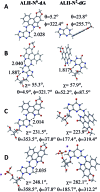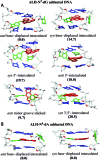Adenine versus guanine DNA adducts of aristolochic acids: role of the carcinogen-purine linkage in the differential global genomic repair propensity
- PMID: 26175048
- PMCID: PMC4551933
- DOI: 10.1093/nar/gkv701
Adenine versus guanine DNA adducts of aristolochic acids: role of the carcinogen-purine linkage in the differential global genomic repair propensity
Abstract
Computational modeling is employed to provide a plausible structural explanation for the experimentally-observed differential global genome repair (GGR) propensity of the ALII-N(2)-dG and ALII-N(6)-dA DNA adducts of aristolochic acid II. Our modeling studies suggest that an intrinsic twist at the carcinogen-purine linkage of ALII-N(2)-dG induces lesion site structural perturbations and conformational heterogeneity of damaged DNA. These structural characteristics correlate with the relative repair propensities of AA-adducts, where GGR recognition occurs for ALII-N(2)-dG, but is evaded for intrinsically planar ALII-N(6)-dA that minimally distorts DNA and restricts the conformational flexibility of the damaged duplex. The present analysis on the ALII adduct model systems will inspire future experimental studies on these adducts, and thereby may extend the list of structural factors that directly correlate with the propensity for GGR recognition.
© The Author(s) 2015. Published by Oxford University Press on behalf of Nucleic Acids Research.
Figures





Similar articles
-
Conformational preferences of DNA following damage by aristolochic acids: Structural and energetic insights into the different mutagenic potential of the ALI and ALII-N(6)-dA adducts.Biochemistry. 2015 Apr 21;54(15):2414-28. doi: 10.1021/bi501484m. Epub 2015 Apr 8. Biochemistry. 2015. PMID: 25761009
-
Structure and stability of DNA containing an aristolactam II-dA lesion: implications for the NER recognition of bulky adducts.Nucleic Acids Res. 2012 Mar;40(6):2759-70. doi: 10.1093/nar/gkr1094. Epub 2011 Nov 25. Nucleic Acids Res. 2012. PMID: 22121223 Free PMC article.
-
Replication of the Aristolochic Acid I Adenine Adduct (ALI-N6-A) by a Model Translesion Synthesis DNA Polymerase: Structural Insights on the Induction of Transversion Mutations from Molecular Dynamics Simulations.Chem Res Toxicol. 2020 Oct 19;33(10):2573-2583. doi: 10.1021/acs.chemrestox.0c00183. Epub 2020 Oct 6. Chem Res Toxicol. 2020. PMID: 32975111
-
Thermodynamic and structural factors in the removal of bulky DNA adducts by the nucleotide excision repair machinery.Biopolymers. 2002 Nov 5;65(3):202-10. doi: 10.1002/bip.10239. Biopolymers. 2002. PMID: 12228925 Review.
-
Mutational signature of aristolochic acid: Clue to the recognition of a global disease.DNA Repair (Amst). 2016 Aug;44:205-211. doi: 10.1016/j.dnarep.2016.05.027. Epub 2016 May 20. DNA Repair (Amst). 2016. PMID: 27237586 Review.
Cited by
-
Local and Systemic Oxidative Stress in Balkan Endemic Nephropathy Is Not Associated with Xanthine Oxidase Activity.Oxid Med Cell Longev. 2020 Aug 18;2020:8209727. doi: 10.1155/2020/8209727. eCollection 2020. Oxid Med Cell Longev. 2020. PMID: 32908640 Free PMC article.
-
Comparison of Genomic Characterization in Upper Tract Urothelial Carcinoma and Urothelial Carcinoma of the Bladder.Oncologist. 2021 Aug;26(8):e1395-e1405. doi: 10.1002/onco.13839. Epub 2021 Jun 8. Oncologist. 2021. PMID: 34050578 Free PMC article.
-
Worldwide research trends on aristolochic acids (1957-2017): Suggestions for researchers.PLoS One. 2019 May 2;14(5):e0216135. doi: 10.1371/journal.pone.0216135. eCollection 2019. PLoS One. 2019. PMID: 31048858 Free PMC article.
-
Thymines opposite to bulky aristolactam-DNA adducts in duplex DNA are not targeted by human thymine-DNA glycosylase.PeerJ. 2025 Jul 4;13:e19577. doi: 10.7717/peerj.19577. eCollection 2025. PeerJ. 2025. PMID: 40625924 Free PMC article.
-
Whether aristolochic acid directly drives hepatocarcinogenesis: comprehensive investigations from mutational signatures to animal models.Arch Toxicol. 2025 May 30. doi: 10.1007/s00204-025-04087-z. Online ahead of print. Arch Toxicol. 2025. PMID: 40445366 Review.
References
-
- Debelle F.D., Vanherweghem J.-L., Nortier J.L. Aristolochic acid nephropathy: a worldwide problem. Kidney Int. 2008;74:158–169. - PubMed
-
- De Broe M.E. Chinese herbs nephropathy and Balkan endemic nephropathy: toward a single entity, aristolochic acid nephropathy. Kidney Int. 2012;81:513–515. - PubMed
-
- Arlt V.M., Stiborová M., vom Brocke J., Simões M.L., Lord G.M., Nortier J.L., Hollstein M., Phillips D.H., Schmeiser H.H. Aristolochic acid mutagenesis: molecular clues to the aetiology of balkan endemic nephropathy-associated urothelial cancer. Carcinogenesis. 2007;28:2253–2261. - PubMed
Publication types
MeSH terms
Substances
LinkOut - more resources
Full Text Sources
Other Literature Sources

